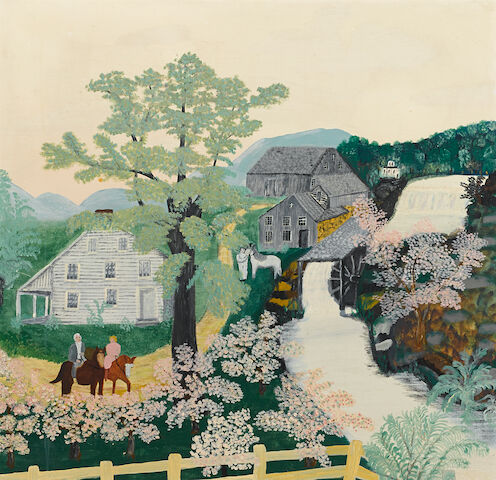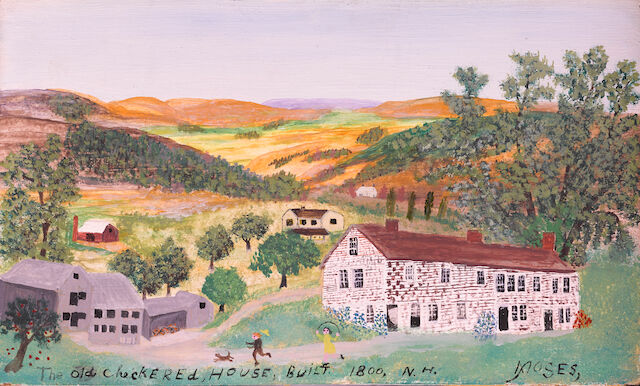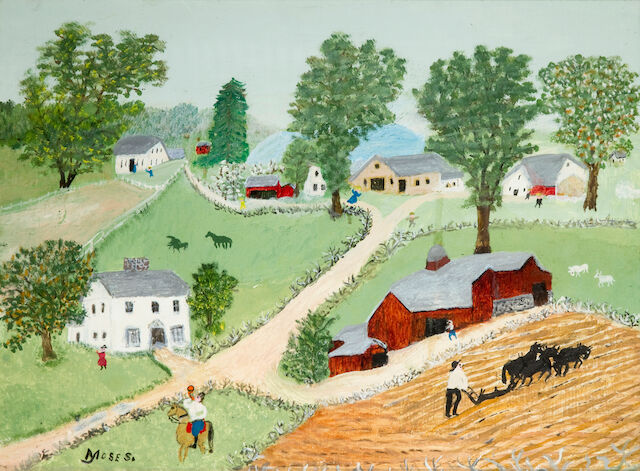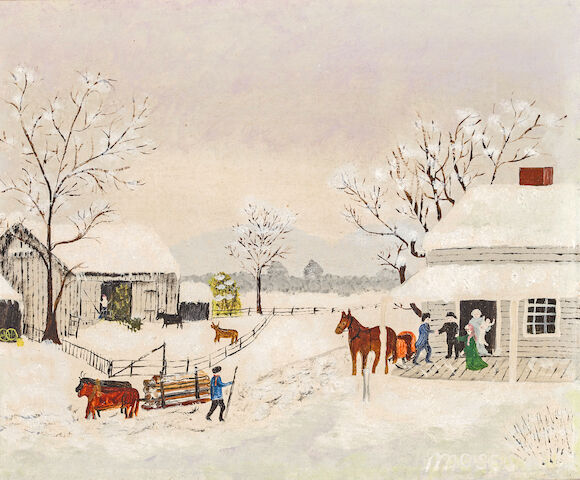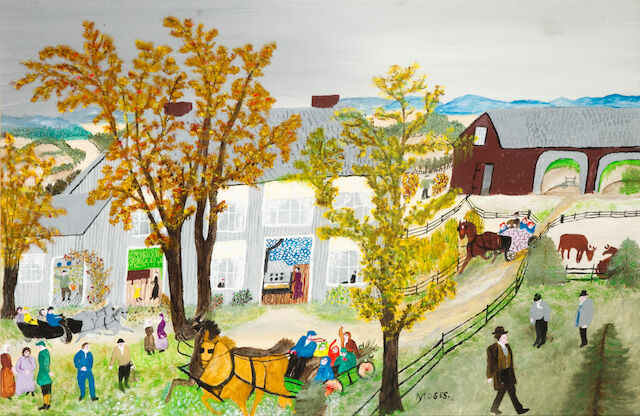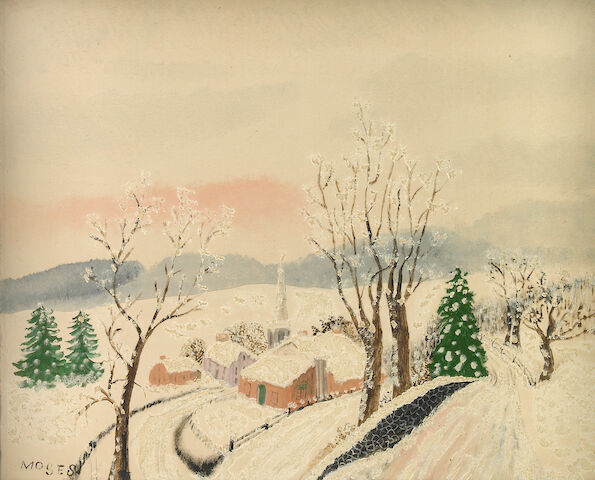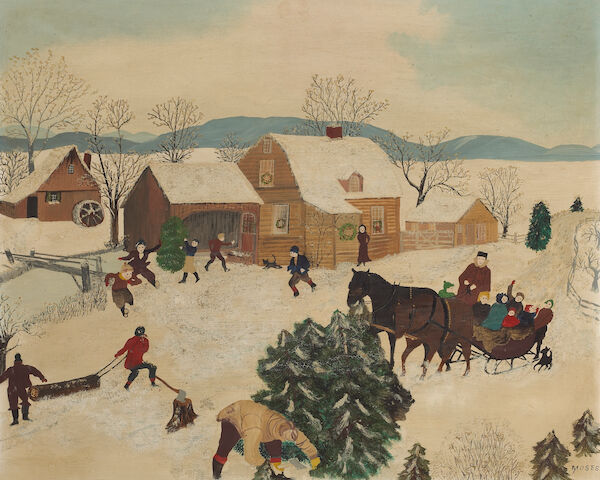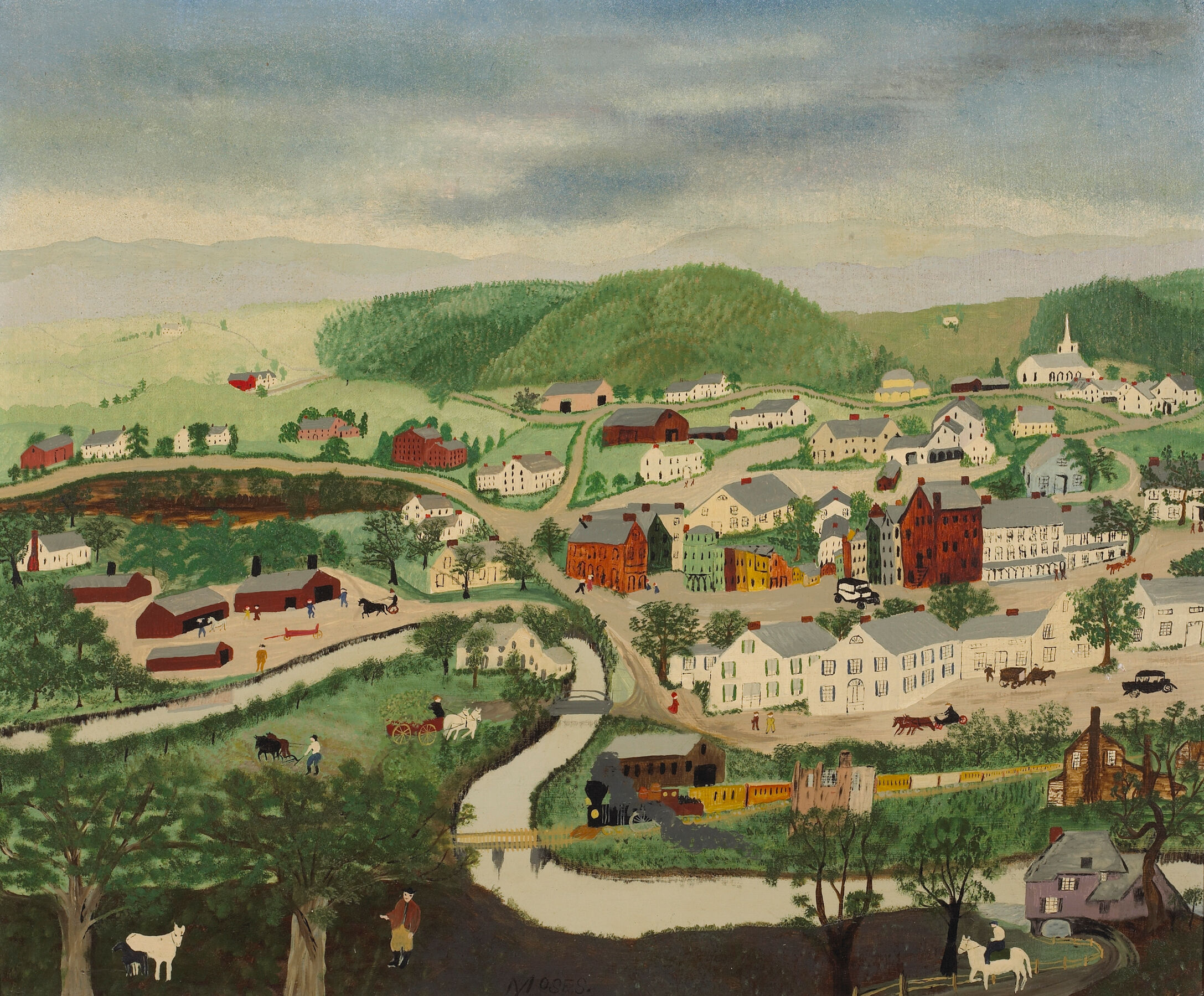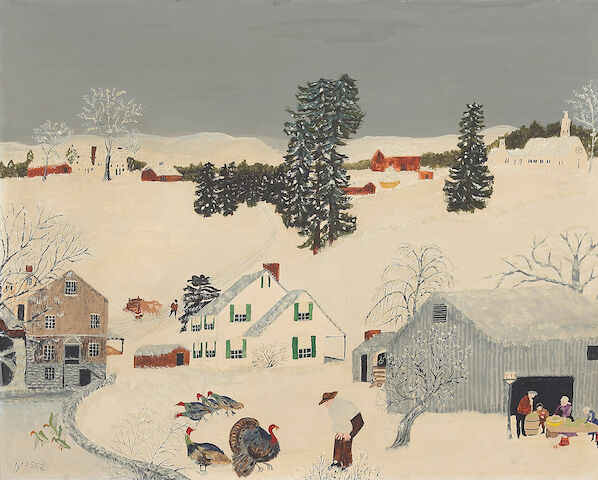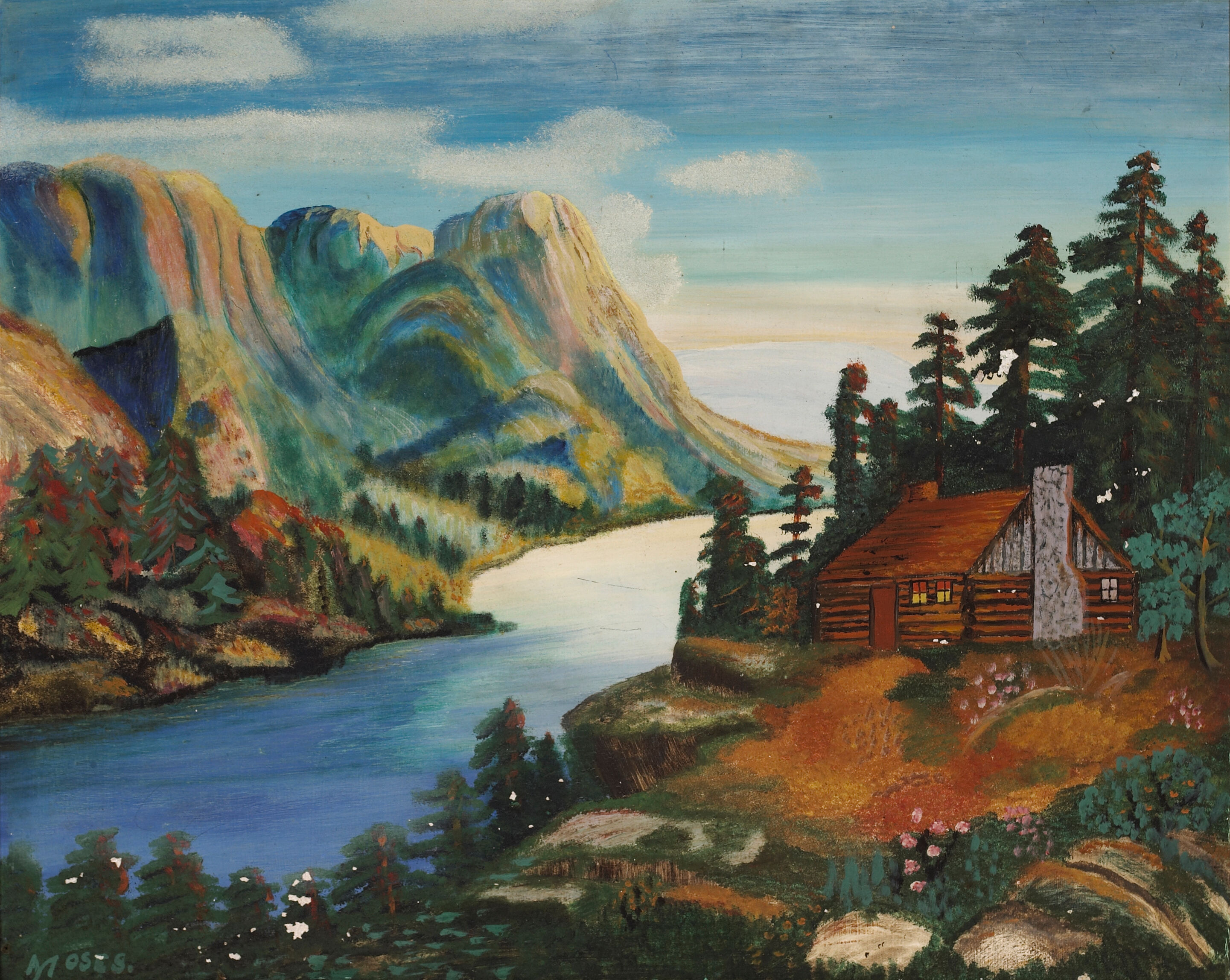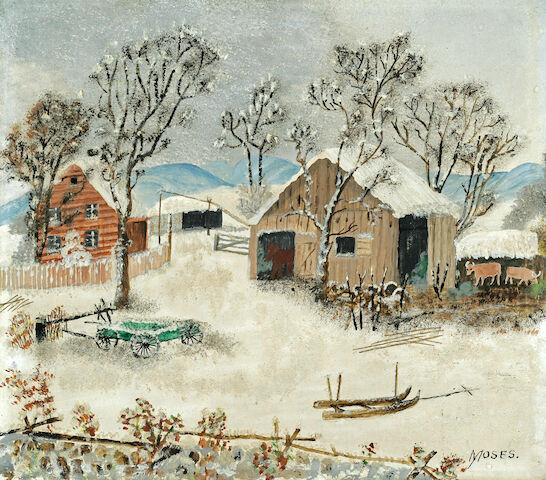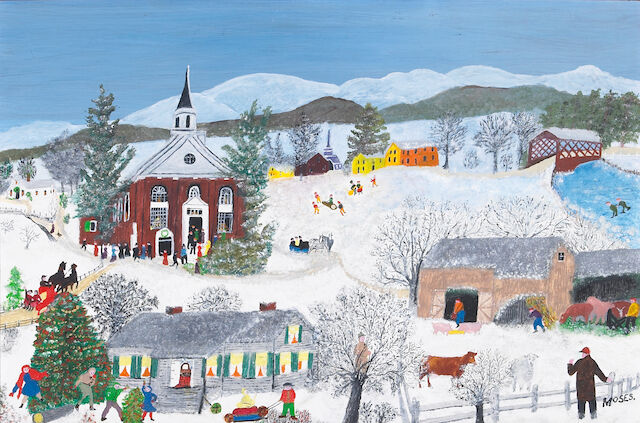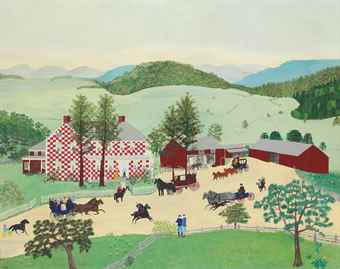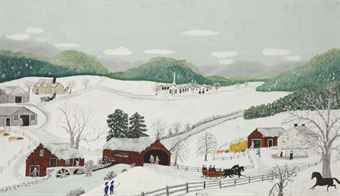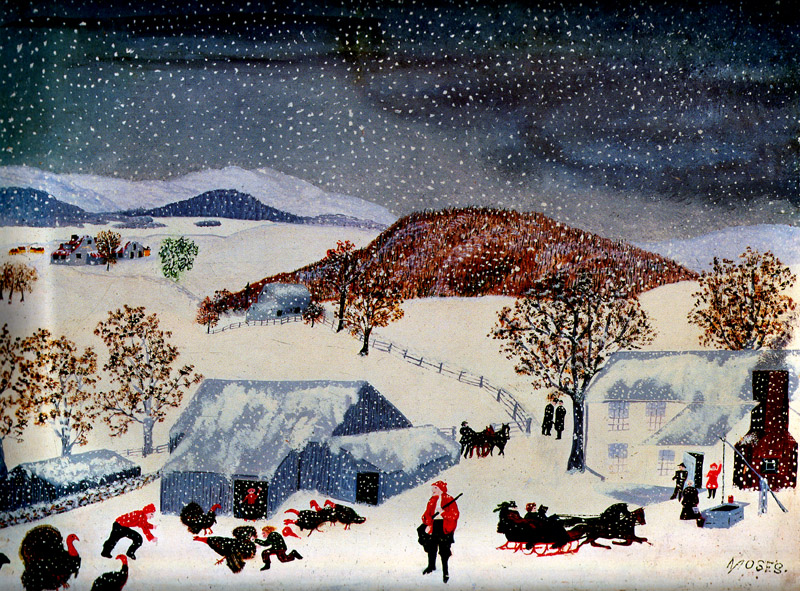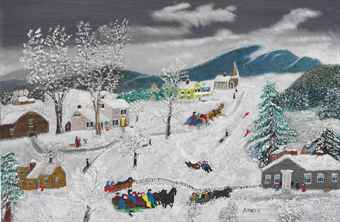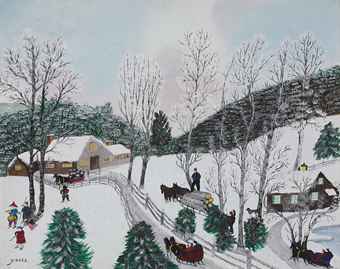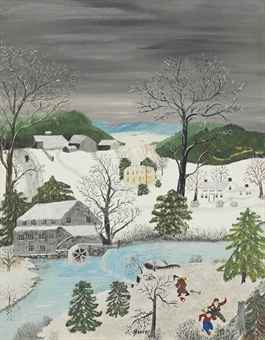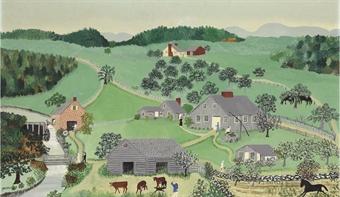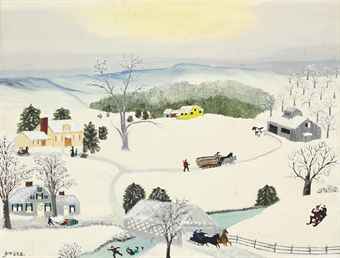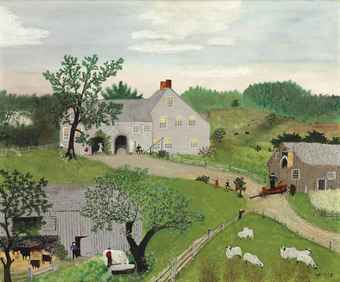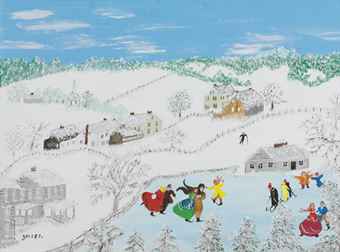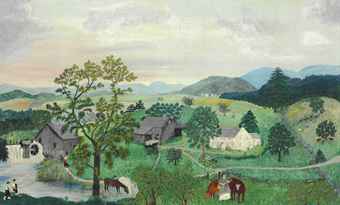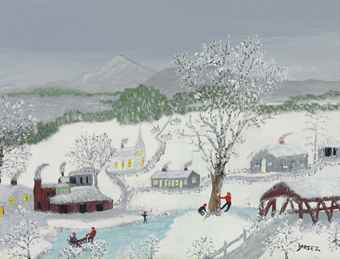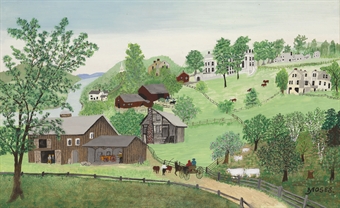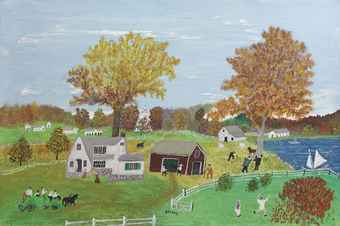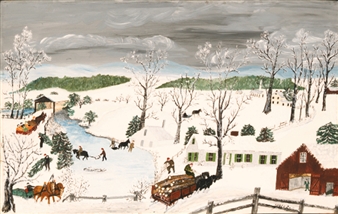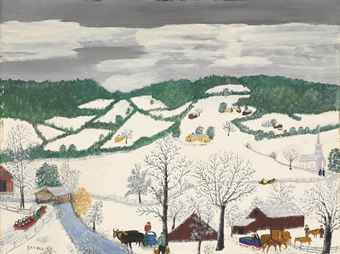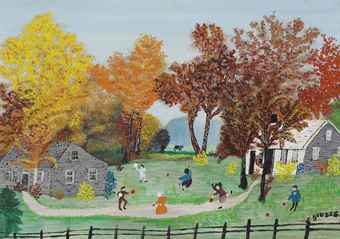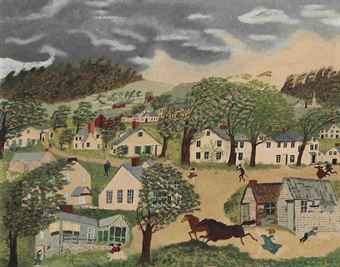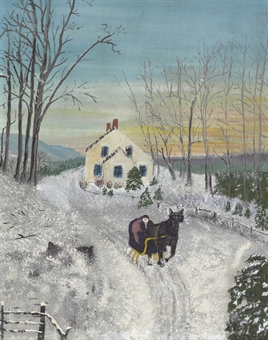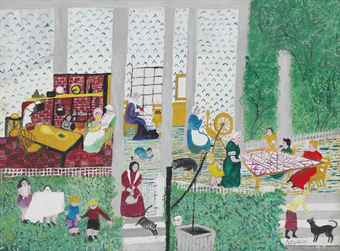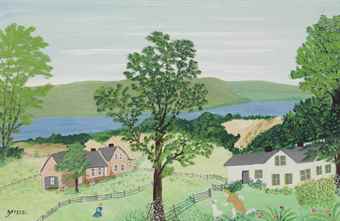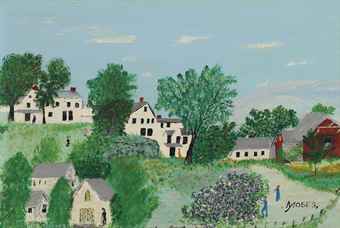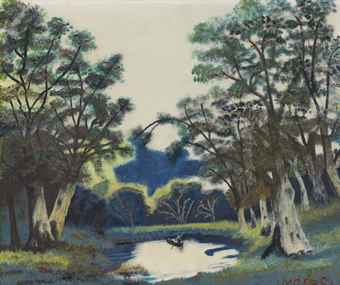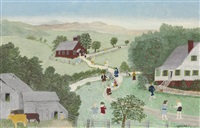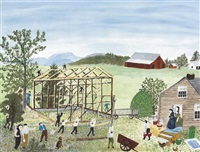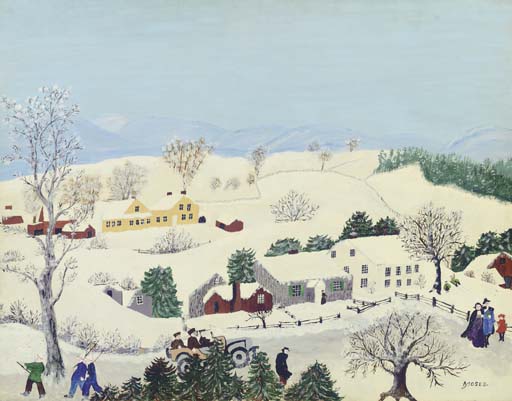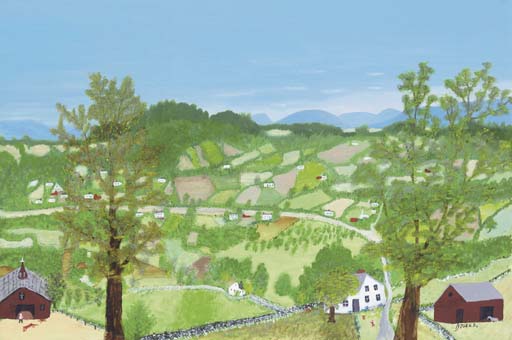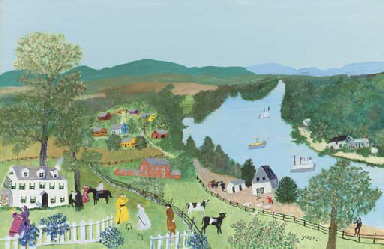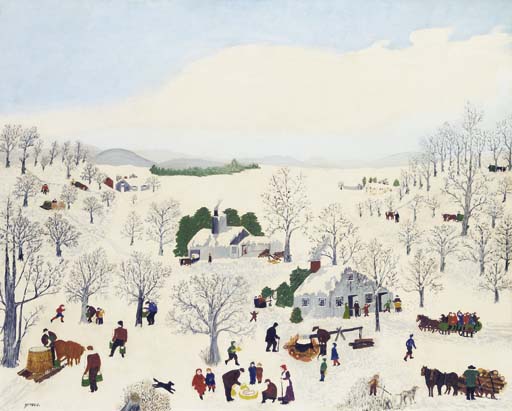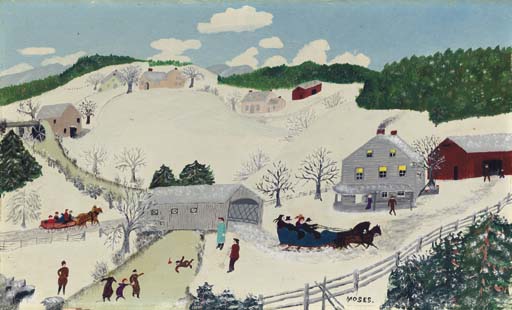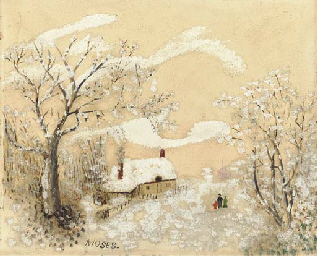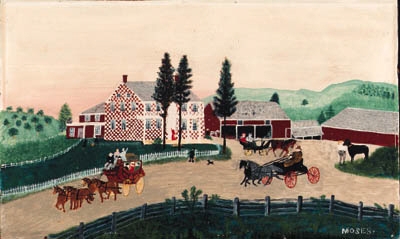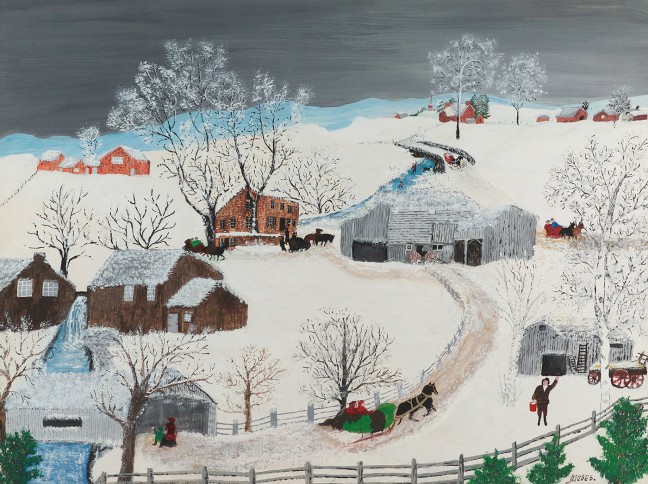Biography - Questroyal Fine Art, LLC, New York, New York
By Amy SpencerGrandma Moses was one of America’s best-known folk artists. She spent her life working on farms in upstate New York and rural Virginia, and did not take up painting seriously until she was seventy-five years old. Inspired by childhood memories, Moses’ works depict the farm activities and natural phenomena of rural life. Through simplified realism, nostalgic atmospheres, and luminous color, Moses achieved a wide following of art lovers.
Moses’ style was described as “American primitive” by her contemporaries in the art world, but she always rejected this label as derogatory. Since her death in 1961, art historians have reexamined Moses’ oeuvre from new perspectives, considering alternative terms to describe an artist who did not have conventional training and credentials. However, as Moses’ legend lives on it becomes increasingly unnecessary to classify her paintings beyond the mainstream of Modernism.
As Peter Schjeldahl wrote in his review of Moses’ 2001 exhibition at the National Museum of Women in the Arts: “Moses fell victim to the sterile categories of ‘naïve’ and ‘outsider’ and ‘self-taught’ . . . The truth is that every genuine artist—and, preeminently, every great one, like Pollock—retains childlike and alienated qualities and remains self-taught where it counts. Moses belongs smack inside the canon of twentieth-century art.”
Grandma Moses was born as Anna Mary Robertson in Greenwich, Washington County, New York, on September 7, 1860. Her parents, Russell King Robertson and Margaret Shannahan, were farmers and she was the third born of ten children. Russell and Margaret owned a flax mill and, from an early age, Moses worked at farm tasks in order to help keep the household running. She attended school only sporadically. Despite the continual hard work of her childhood Moses recalls it fondly in her autobiography, noting that a favorite treat was when her father brought her paper for drawing.
At age twelve, Moses began earning her living as a “hired girl” in wealthier homes around Greenwich. She worked on various farms for the next fifteen years. In 1887, Moses married Thomas Salmon Moses. The couple moved to a rented farm in Augusta County, Virginia. Over the next decade the Moses’ occupied several different farms in the Shenandoah Valley, until, at the turn of the century, they saved enough to buy their own place. Moses had ten children while living in Virginia, only five of which survived past infancy. As the matriarch of her family she became known to her neighbors as “Mother Moses.”
In 1905, Moses and her family returned north, buying a farm in Eagle Bridge, New York, not far from her birthplace. As the family became more established and her children began entering adulthood, Moses had more recreational time. She had sewn and embroidered throughout her life; however, as she got older she devoted more time to purely artistic projects and also began dabbling with painting. Her earliest known painting, Fireboard (Private collection; 1918), created when she was fifty-eight, was painted on the board used to seal off the fireplace in summer.
Moses’ husband died suddenly in 1927. In 1932, Moses moved to Bennington to take care of her daughter, Anne, who had tuberculosis. While living with Anne, Moses began stitching what she termed “worsted pictures” made from embroidery yarn. The tonal effects Moses achieved with the yarn––color-blocking and subtle layering of different threads side by side to achieve shades––was a great influence in her later painting technique.
Anne died in 1933 and Moses returned to Eagle Bridge. By this time, her arthritis was making it increasingly difficult to hold a needle, so she began to focus on painting. At first, Moses copied illustrated postcards and Currier & Ives prints; however, she gradually began to re-create scenes from her childhood through a mix of recreating figurative elements from found sources and piecing them together with scenes from her imagination. Moses’ favorite subjects were landscapes showing happy scenes of rural life, changing seasons and weather, rolling hills, and abundant crops. The people in her paintings are actively engaged in farm tasks, and, although each has separate narratives, they are all part of the established order of farm life. She also painted some history paintings and interior scenes.
In 1936, a friend in the neighboring town of Hoosick Falls invited Moses to display her paintings in the window of a drugstore as part of the local Women’s Exchange. These paintings sat in the window for two years until, during Easter week of 1938, a New York City collector named Louis J. Caldor passed through town. Caldor had a hobby of seeking out local art and craft talent in country towns and Moses’ paintings caught his eye. Caldor immediately brought all of Moses’ displayed works.
For the next few years Caldor took his collection of Moses paintings to museums and galleries in New York City. At first there was little interest in the paintings, particularly when people found out Moses’ age; however, Caldor finally had success in 1939 when three of Moses’ paintings were selected for a private exhibition of unknown artists at The Museum of Modern Art.
In October of the next year, Moses had her first solo exhibition at Otto Kallir’s Galerie St. Etienne in New York. The following month her paintings were displayed in Gimbels Department Store. Moses visited the store for the show’s opening where, perhaps likening the experience to visiting a county fair, she delivered a speech on the topic of jams and preserved fruits. The New York press was delighted by the down-to-earth Moses who received the attention with good humor, saying: “If they want to make a fuss over me I guess I don’t mind.”
Nevertheless, she admitted that New York City did not interest her greatly and that she was eager to get back to the farm. Unsurprisingly, Moses eventually found managing her artistic career too much to handle and had Kallir at Gallerie St. Etienne and Ala Story at the American British Art Center represent her exclusively.
With professional management, Moses’ national and international fame was quickly established through a secession of events. In 1946, Kallir edited the first monograph on the artist, Grandma Moses, American Primitive. (Later versions were simply called Grandma Moses after the artist took offence to the term “primitive.”) In 1949, Moses traveled to Washington D.C. where President Truman bestowed on her the Women’s National Press Club Award. Moses’ work had its first European exposure in 1950 with an exhibition of fifty works touring Vienna, Munich, Salzburg, Berne, The Hague, and Paris. The same year, a documentary film on the artist was nominated for an Academy Award and two years later Lillian Gish portrayed her in a live television movie.
In 1955, Edward R. Murrow interviewed Grandma Moses on CBS's “See It Now”. While Moses was increasingly in the spotlight, she rarely left her farm in upstate New York and made few concessions to her new affluence. Her biggest luxury was building a ranch-style home across the street when the stairs in her old home became too difficult to manage.
In 1952, Moses’ published her autobiography, My Life’s History. This book is the most important source of primary information about the artist, specifically providing insights into her tastes, composition ideas, work ethic, and even her views on feminism (Moses wrote: “I think women should vote, they have to make a living just the same as the men do, so why should they not have a say-so?”
Most significantly, My Life’s History shows Moses’ ongoing interest in painting and creativity, helping to explain her rapid transformation from farm wife to artist. While Moses’ initial fame may have been a novelty to the New York press, My Life’s History demonstrates that Moses was a disciplined artist all her life, albeit one whose circumstances rarely allowed her to paint.
On Moses’ 100th birthday in 1960, the New York Governor, Nelson Rockefeller, proclaimed the day as “Grandma Moses Day” to honor the artistically talented woman. One year later, Grandma Moses died on December 13, 1961. She was buried in the Maple Grove Cemetery in Hoosick Falls, New York.
1860 Anna Mary Robertson Moses is born in Greenwich, New York on September 7, the third of ten children, to Russell King Robertson and Margaret Shannahan
Spends childhood working on the farm and attends school for only brief periods at a time
1872 Leaves home to work as a hired girl at houses near the family farm
1887 Marries Thomas Salmon Moses
Moves to a rented farm near Staunton, Virginia where, over the next fifteen years Moses has ten children, five of who die in infancy
1907 Moves to a farm in Eagle Bridge, New York
1918 Paints earliest known work, Fireboard (Private collection; 1918)
1927 Moses’ Husband, Thomas, dies
1932 Moves to Bennington to take care of daughter who has tuberculosis; makes worsted pictures from embroidery yarn during this period
1933 Daughter dies and Moses returns to live at Eagle Bridge
Around this time, at age seventy-six, gives up embroidery due to arthritis and begins to paint
1936 Displays paintings in the window of a drugstore in Hoosick Falls as part of a local Women’s Exchange
1938 Moses’ paintings are noticed by art collector and engineer, Louis Caldor, when he drives through Eagle Bridge and sees them in a store window for sale
1939 Exhibits in a private exhibition of contemporary unknown painters at the Museum of Modern Art in New York
1940 Has first solo exhibition at Otto Kallir’s Galerie St. Etienne in New York
Exhibits paintings at Gimbels department store
1944 Otto Kallir and Ala Story begin representing Moses
1946 Biography by Otto Kallir is published, Grandma Moses, American Primitive (Doubleday and Co.)
1949 Travels to Washington D.C. where President Truman awards her the Women’s National Press Club Award
Receives honorary doctoral degree from Russell Sage College, New York
1950 First European exhibition tours Vienna, Munich, Salzburg, Berne, The Hague, and Paris
Documentary of Moses’ life is nominated for an Academy Award
1952 Lillian Gish portrays Moses in a television movie about her life
1951 Builds a new ranch style home for herself at Eagle Bridge
Receives honorary doctoral degree from Moore Institute of Art, Science and Industry, Philadelphia
1952 Publishes autobiography, My Life’s History (Harper and Brothers)
1955 Is interviewed by Edward R. Murrow on CBS's “See It Now”
1960 Celebrates 100th birthday
1961 Dies on December 13
Estimate 40,000 — 60,000 Lot Sold 81,250
Estimate 15,000 — 25,000 Lot Sold 20,000
Sotheby’s May 21, 2009
Though
Grandma Moses enjoyed painting as a small child, as an adult the demands of
daily farm life and raising children prevented her from devoting her time to
studying art. Not until she reached the age of 70 was Moses – or Grandma as she
then preferred to be known – able to devote her attention to painting. She
became a prolific artist, painting over 1,600 pictures, many of which depict
her family’s happiest moments in the countryside. Without any formal artistic
training, Grandma Moses’s subjects were drawn from her life as a mother and
farmer’s wife both in the Shenandoah Valley and in Hoosick Falls, New York.
Sold for US$ 68,750
inc.premium
Bonhams November 28, 2012
Grandma Moses (American, 1860-1961)
Home for Thankgiven
8 x 9 3/4in
Grandma Moses (American, 1860-1961)
'Hoosick Falls', 1944
21 1/2 x 26in
Bonhams November 28, 2012
Grandma Moses (American, 1860-1961)
Home for Thankgiven
8 x 9 3/4in
Sold for US$ 23,750
Grandma Moses (American, 1860-1961)
Thanksgiving
16 x 24in
Sold for US$ 40,000 i
Bonhams 2011
Grandma Moses (American, 1860-1961)
Looking afar off, 1942
9 1/4 x 11in
Sold for US$ 15,860
Bonhams 2009
Grandma Moses (American, 1860-1961)
Hurrah for Christmas,
1942 18 x 22in
Sold for US$ 42,700
Grandma Moses (American, 1860-1961)
'Hoosick Falls', 1944
21 1/2 x 26in
US$ 80,000 - 100,000
Grandma Moses (American, 1860-1961)
A Fine Gobbler, 1948
15 1/2 x 19 1/2in
Sold for US$ 64,050
Bonhams 2008
Grandma Moses (American, 1860-1961)
In the Adirondacks
16 x 20in
US$ 30,000 - 50,000
Bonhams 2007
Grandma Moses (American, 1860-1961)
The Old Barn in Winter
9 3/4 x 11in
US$ 20,000 - 30,000
Bonhams 2006
Grandma Moses (Anna M. Robertson) (1860-1961)
December (Going to Church), 1956
16 x 24in
Sold for US$ 88,500
Christie's
Over the River to Grandma's House
PRICE REALIZED
Sugaring Off
PRICE REALIZED
Catching the Thanksgiving Turkey
PRICE REALIZED
November
PRICE REALIZED
Beautifull Thankgiven
PRICE REALIZED
Taking Leg Bale for Security
PRICE REALIZED
Whoa There
PRICE REALIZED
Watering the Horses
PRICE REALIZED
Skating
PRICE REALIZED
$80,500
PR.$32,900
Christie's 2008
Christie's 2008
Christie’s 2007
Christie’s 2006
Christie’s 2004
Christie’s 2001
Christie's 2000
Christie's 1999
Anna Mary Robertson “Grandma” Moses (1860–1961)
The Brown Mills, May 20, 1951
Oil on board
18 x 24 inches
Signed lower right: MOSES.
The Brown Mills, May 20, 1951
Oil on board
18 x 24 inches
Signed lower right: MOSES.


